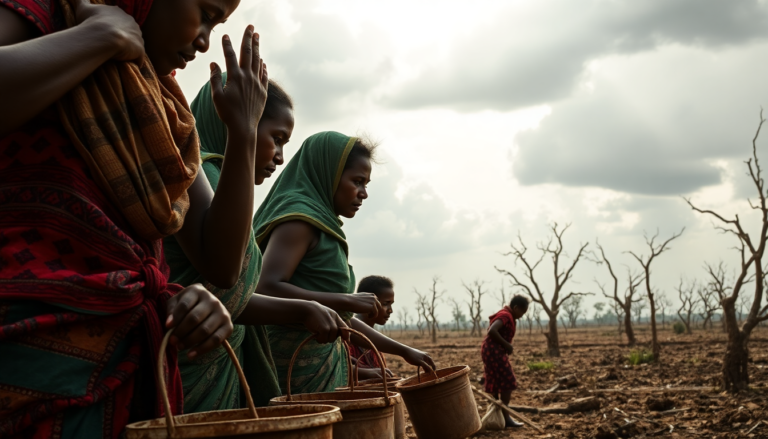Argomenti trattati
Understanding the Connection Between Climate Change and Gender-Based Violence
For many years, feminist organizations have spotlighted the alarming reality that climate change significantly escalates violence against women and girls. This is not just a statistic; it is a human rights crisis impacting at least one in three women globally. The intricate relationship between climate change and gender-based violence has often been difficult to quantify. However, a new report titled ‘Colliding Crises: How the Climate Crisis Fuels Gender-based Violence’ sheds light on these pressing issues, revealing how intertwined these challenges truly are.
Projected Increases in Violence Due to Climate Change
According to the report, by 2090, we could see an additional 40 million women and girls experiencing intimate partner violence (IPV) annually if global temperatures rise by 2°C. With many scientists estimating we may surpass the 1.5°C threshold as early as the end of 2024, these projections are not just numbers—they represent real lives at risk. Furthermore, an additional 10 million women and girls might face non-partner sexual violence in the same timeframe. This implies that around 10% of IPV cases could be attributed directly to climate change if current trends continue.
Research indicates that each 1°C increase in temperature correlates with a staggering 4.7% rise in IPV incidents. The link between extreme weather events and violence is becoming increasingly evident as these occurrences become more frequent and severe.
The Role of Gender Dynamics in the Face of Climate Disasters
The underlying cause of violence against women and girls stems from entrenched gender power dynamics that are aggravated by climate-related disasters. Events such as droughts, floods, and storms create conditions that heighten vulnerability—displacement, poverty, and institutional breakdowns that reinforce harmful norms and behaviors. For instance, violence often surges in displaced populations where families are forced to live in cramped conditions without adequate resources. This confinement can trap women and girls with their abusers, severely limiting their access to emergency services and shelters.
- Increased human trafficking and sexual exploitation have been documented following natural disasters.
- Resource scarcity has led to violent conflicts, with sexual violence used as a tool for intimidation.
The Escalation of Violence Under Climate Stress
The severity of violence is also escalating due to climate change, which puts over a billion women and girls at heightened risk. Studies have shown that those who have already experienced IPV are likely to face more severe forms of violence as temperatures rise. This concerning trend raises the potential for extreme violence types, including femicide and sexual exploitation. For instance, during heatwaves, intimate partner femicide rates have reportedly increased by up to 28%.
How Climate Change Disrupts Critical Services
Environmental changes from climate change disrupt essential services such as education, healthcare, and local governance. This disruption not only hampers violence prevention programs but also limits survivors’ access to vital resources, including communication networks and shelters. As infrastructure crumbles under the strain of climate change, the safety nets that support vulnerable populations are increasingly compromised.
Women’s Leadership in Climate Action is Crucial
While climate change poses a significant threat to women’s rights, it also impedes their ability to engage in and lead climate action. Women environmental defenders, particularly those from Indigenous communities, face targeted violence as they advocate for change. They encounter threats ranging from harassment to physical violence, particularly when standing up against corporate interests or state actions that threaten their communities.
For example, in Guatemala, women who reported illegal logging faced retaliatory violence from their own neighbors, resulting in forced evictions and arson. This highlights the grave risks women face when they attempt to protect their rights and advocate for sustainable practices.
Integrating Solutions to Address Both Crises
Addressing violence against women and climate change must not be viewed as separate agendas; they are mutually reinforcing issues that require an integrated approach. Women’s active involvement in political processes and climate initiatives has proven beneficial for effective policy-making. More gender-balanced parliaments tend to enact stricter climate policies, demonstrating that gender equality is vital for climate action.
However, to make meaningful progress, violence prevention and climate change initiatives must align more closely than they currently do. This calls for increased funding and political will to tackle both issues concurrently, fostering resilience and empowerment among women and girls worldwide.
Learn More About the Ongoing Efforts
To discover more about how organizations like the Spotlight Initiative are working to combat gender violence while advocating for climate-sensitive policies, refer to the full brief, ‘Colliding Crises: How the Climate Crisis Fuels Gender-based Violence’. The need for urgent action has never been clearer, and understanding these interconnections is a critical step towards a more equitable and sustainable future.

